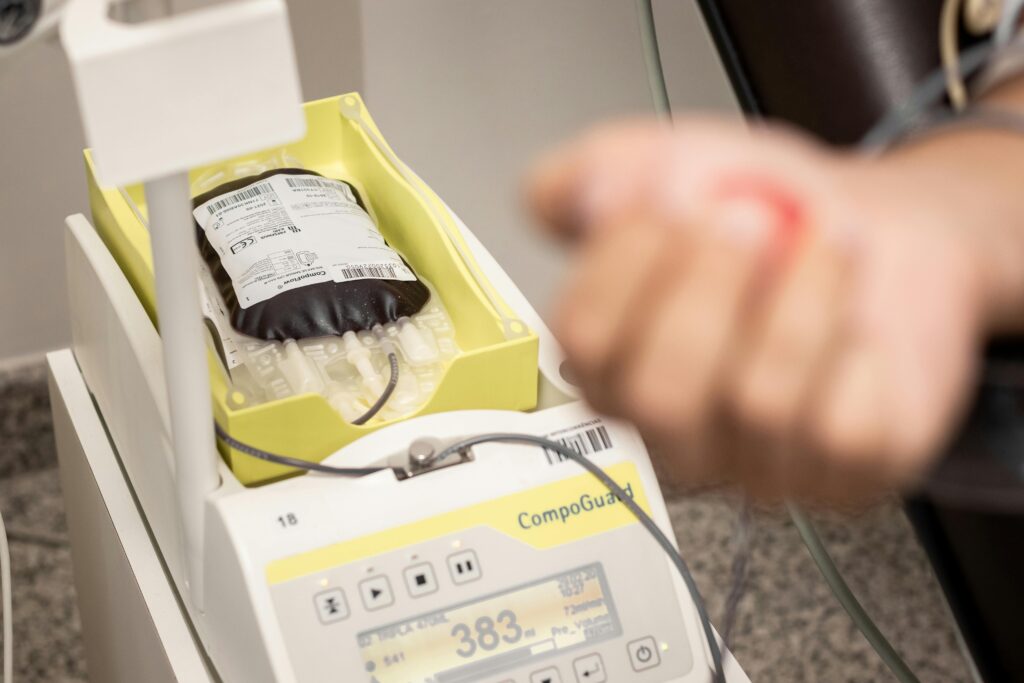
1. Introduction to Blood Transfusion
- Historical Context: Blood transfusion has been a life-saving medical intervention since the first successful transfusion in 1818. Over time, advancements in screening, processing, and storage have made transfusions safer and more effective.
- Importance in Modern Medicine: Blood transfusions are critical in managing acute blood loss, perioperative anemia, and chronic anemia. They are also essential in trauma, surgery, and managing coagulopathies.
2. Blood Donation and Screening
- Donor Selection: Donors are rigorously screened to ensure their blood is safe for recipients. This includes medical history, physical examination, and laboratory testing.
- Infectious Disease Testing: Donated blood is tested for hepatitis B, hepatitis C, HIV-1, HIV-2, and syphilis. Leukodepletion is performed to reduce the risk of variant Creutzfeldt-Jakob disease (vCJD) and to lower immunogenicity.
- Blood Grouping: ABO and RhD typing are performed, along with screening for irregular red cell antibodies.
3. Blood Components and Their Uses
- Whole Blood: Rarely used in civilian practice due to inefficiency, but it is rich in coagulation factors and metabolically active if fresh.
- Packed Red Blood Cells (PRBCs): Concentrated red cells with a hematocrit of 50-70%. Stored in SAGM (saline-adenine-glucose-mannitol) solution for up to 5 weeks.
- Fresh-Frozen Plasma (FFP): Rich in coagulation factors, used for coagulopathic hemorrhage. Stored at -40 to -50°C with a 2-year shelf life.
- Cryoprecipitate: Contains high levels of factor VIII and fibrinogen, used in low fibrinogen states or factor VIII deficiency. Stored at -30°C for up to 2 years.
- Platelets: Used for thrombocytopenia or platelet dysfunction. Stored at 20-24°C with a shelf life of 5 days.
- Prothrombin Complex Concentrates (PCC): Used for emergency reversal of anticoagulant therapy (e.g., warfarin) in uncontrolled hemorrhage.
4. Indications for Blood Transfusion
- Acute Blood Loss: To restore circulating volume and maintain oxygen delivery.
- Perioperative Anemia: To ensure adequate oxygen delivery during surgery.
- Chronic Anemia: For symptomatic patients without active bleeding or impending surgery.
- Transfusion Triggers: Historically, a hemoglobin level of 10 g/dL was targeted, but current guidelines suggest lower thresholds (e.g., 6-8 g/dL) for stable patients without active bleeding.
5. Blood Groups and Cross-Matching
- ABO System: The ABO blood group system is based on the presence or absence of A and B antigens on red cells. Group O is the universal donor, while group AB is the universal recipient.
- Rh System: The RhD antigen is highly immunogenic. Rh-negative individuals can develop antibodies if exposed to Rh-positive blood, which is critical in pregnancy and transfusion medicine.
- Cross-Matching: Ensures compatibility between donor and recipient blood to prevent transfusion reactions. Full cross-matching takes up to 45 minutes, but type-specific blood can be issued in 10-15 minutes in emergencies.
6. Complications of Blood Transfusion
- Acute Hemolytic Reaction: Caused by ABO incompatibility, leading to intravascular hemolysis and organ failure.
- Febrile Non-Hemolytic Reaction: Caused by leukocytes in transfused blood, leading to fever and chills.
- Allergic Reactions: Mild to severe allergic responses to plasma proteins.
- Infections: Rare but serious risks include bacterial contamination, hepatitis, HIV, and malaria.
- Transfusion-Related Acute Lung Injury (TRALI): A severe reaction often associated with FFP transfusion.
- Massive Transfusion Complications: Coagulopathy, hypocalcemia, hyperkalemia, hypokalemia, and hypothermia.
7. Management of Coagulopathy
- Balanced Transfusion: A 1:1:1 ratio of PRBCs, FFP, and platelets is recommended for active hemorrhage to prevent dilutional coagulopathy.
- Antifibrinolytic Agents: Tranexamic acid (TXA) is used empirically to reduce fibrinolysis in bleeding patients.
- Monitoring Coagulation: Point-of-care testing (e.g., thromboelastometry) or laboratory tests (e.g., fibrinogen, clotting times) guide transfusion and coagulation management.
8. Autologous Blood Transfusion
- Pre-Donation: Patients can donate their own blood before elective surgery for retransfusion during the procedure.
- Intraoperative Cell Salvage: Blood lost during surgery can be collected, washed, and reinfused to the patient.
9. Emerging Alternatives to Blood Transfusion
- Hemoglobin-Based Oxygen Carriers (HBOCs): Engineered hemoglobin molecules from human, bovine, or recombinant sources are under clinical trials.
- Perfluorocarbon Emulsions: Synthetic oxygen carriers that show promise in early clinical trials.
- Blood Substitutes: Aim to reduce the reliance on donated blood, lower costs, and eliminate infectious risks.
10. Administration and Safety Protocols
- Verification Process: Two healthcare personnel must verify patient details, blood type, and donor blood serial number before transfusion.
- Emergency Transfusion: In life-threatening situations, group O blood (O- for females, O+ for males) is used as a universal donor.
11. Special Considerations
- Patients on Antiplatelet Therapy: Managing hemorrhage in patients on clopidogrel or aspirin can be challenging. Platelet transfusions or desmopressin (DDAVP) may be required.
- Massive Transfusion Protocols (MTP): Activated for severe hemorrhage, involving rapid transfusion of blood products in a 1:1:1 ratio.
- Iron Overload: Patients receiving repeated transfusions (e.g., thalassemia) may develop iron overload, requiring chelation therapy.
SEO-Optimized Key Points:
- Blood Donation and Screening: Rigorous donor screening and infectious disease testing ensure safe blood transfusions.
- Blood Components: PRBCs, FFP, cryoprecipitate, and platelets each have specific indications and storage requirements.
- Transfusion Triggers: Lower hemoglobin thresholds (6-8 g/dL) are now recommended for stable patients without active bleeding.
- ABO and Rh Systems: Understanding blood groups and cross-matching is critical to prevent transfusion reactions.
- Complications: Acute hemolytic reactions, TRALI, and infections are rare but serious risks of transfusion.
- Coagulopathy Management: Balanced transfusion (1:1:1 ratio) and antifibrinolytics like TXA are key to managing bleeding.
- Emerging Alternatives: HBOCs and perfluorocarbon emulsions are promising alternatives to traditional blood transfusions.
